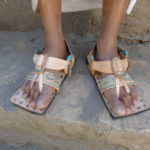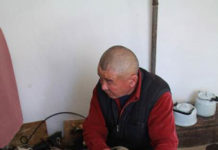The natural leather is widely available in Yemen. Therefore, Yemenis became famous in the old times for tanning and sewing leather products. Handicrafts use leather in many different crafts and part of it is the traditional costumes.
 The name of this craft is called in Yemen almenqalah and the technique is called menaql, which means transformation. So, the handicraft transforms the leather from its nature to a new different shape. They also use the simple and primitive tools as their fathers and grandfathers did, such as scissors, pincers, special knife for cutting leathers, metal puncher and small hammer. The leather footwear and its different types are considered the most important products of this craft.
The name of this craft is called in Yemen almenqalah and the technique is called menaql, which means transformation. So, the handicraft transforms the leather from its nature to a new different shape. They also use the simple and primitive tools as their fathers and grandfathers did, such as scissors, pincers, special knife for cutting leathers, metal puncher and small hammer. The leather footwear and its different types are considered the most important products of this craft.
Leather footwear has an ancient history. It was found on mummies in a mountain cave and which is now at the Archeological College.
During the present time, the position of this craft has chang ed a lot. Although, there were once about 40 shops, today there are only five shops remaining that specialise in producing traditional alsarm leather footwear.
ed a lot. Although, there were once about 40 shops, today there are only five shops remaining that specialise in producing traditional alsarm leather footwear.
Alsarm consists of number of leather pieces. The most important ones are:
- A number of cow leather layers, tanned locally, are cut in a rectangular shape according to the size of the foot, and then bound together.
- A soft piece of goat’s leather (ghazala) is put on the top of the other layers.
- Soft laces of tanned leather manually with green colour are used to varnish the footwear.
- The soft laces of goat’s leather (alqadaim) are used to fix the footwear tight on the foot while wearing.
- Two pieces of leather are fixed on the sides of the footwear and folded to fix the leather laces to make it easy to wear (alathan)
- Strong cotton sewing threads
- A quantity of mustard oil that the footwear is immersed in for a complete day before the footwear is used and that is to make the footwear strong
Mr. Akram Kaidama is the most famous artisan and he is still working on this craft that he has inherited from his family.





